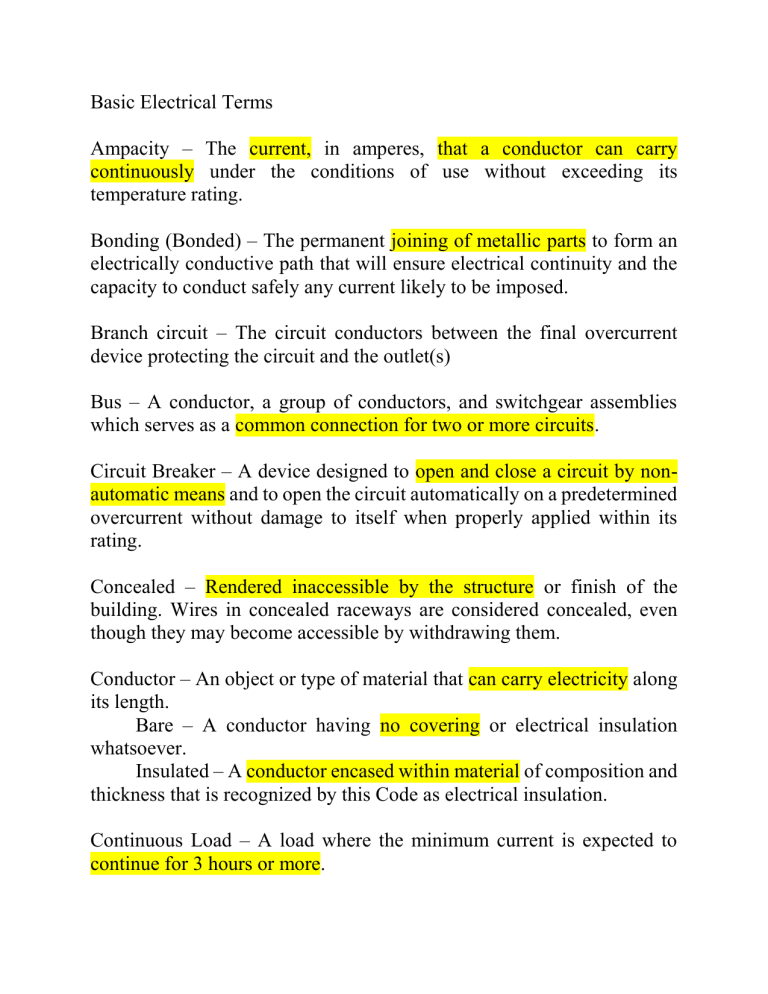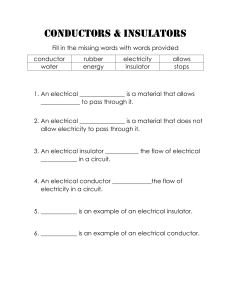
Basic Electrical Terms Ampacity – The current, in amperes, that a conductor can carry continuously under the conditions of use without exceeding its temperature rating. Bonding (Bonded) – The permanent joining of metallic parts to form an electrically conductive path that will ensure electrical continuity and the capacity to conduct safely any current likely to be imposed. Branch circuit – The circuit conductors between the final overcurrent device protecting the circuit and the outlet(s) Bus – A conductor, a group of conductors, and switchgear assemblies which serves as a common connection for two or more circuits. Circuit Breaker – A device designed to open and close a circuit by nonautomatic means and to open the circuit automatically on a predetermined overcurrent without damage to itself when properly applied within its rating. Concealed – Rendered inaccessible by the structure or finish of the building. Wires in concealed raceways are considered concealed, even though they may become accessible by withdrawing them. Conductor – An object or type of material that can carry electricity along its length. Bare – A conductor having no covering or electrical insulation whatsoever. Insulated – A conductor encased within material of composition and thickness that is recognized by this Code as electrical insulation. Continuous Load – A load where the minimum current is expected to continue for 3 hours or more. Cutout Box – an enclosure designed for surface mounting that has swinging doors or covers secured directly to and telescoping with the walls of the box proper. Disconnecting Means – a device, or group of devices, or other means by which the conductors of a circuit can be disconnected from their source of supply. Dwelling – Dwelling unit – one or more rooms for the use of one or more persons as a housekeeping unit with space for eating, living, and sleeping, and permanent provisions for cooking and sanitation. One-Family Dwelling – a building that contain solely of one dwelling unit Two-Family Dwelling – a building that contain solely of two dwelling unit Multifamily dwelling – a building that contain three or more dwelling unit Enclosed – surrounded by a case, housing, fence, or wall(s) that prevents persons from accidentally contacting energized parts. Enclosure – the case or housing of apparatus, or the fence or walls surrounding an installation to prevent personnel from accidentally contacting energized parts, or to protect the equipment from physical damage. Energized – electrically connected to source of potential difference. Exposed (as applied to live parts) – capable of being inadvertently touched or approached nearer than a safe distance by a person. It is applied to parts that are not suitably guarded, isolated, or insulated. Exposed (as applied the wiring methods) – on or attached to the surface or behind panels to allow access Feeder – all circuit conductors between the service equipment, the source of a separately derived system, or other power supply source and the final branch-circuit overcurrent device. Fixture – an integral, separate or self-contained unit which may contain one or more bulbs or fluorescent tubes. Ground – a conducting connection, whether intentional or accidental, between an electrical circuit or equipment and the earth, or to some conducting body that serves in place of the earth. Grounded – effectively, intentionally connected to earth through a ground connection or connections of sufficiently low impedance and having sufficient current carrying capacity to prevent the build-up of voltages that may result in undue hazards the connected equipment or to persons Grounding conductor – a conductor used to connect equipment or the grounded circuit of a wiring system to the grounding electrode or electrodes Guarded – covered, shielded, fenced, enclosed, or otherwise protected by means of suitable covers, casings, barriers, rails, screens, mats, or platforms to remove the likelihood of approach or contact by persons or objects to a point of danger Handhole Enclosure – an enclosure identified for use in underground systems, provided with an open or closed bottom, and sized to allow personnel to reach into, but not enter, for the purpose of installing, operating, or maintaining equipment or wiring or both. Interlock – the device actuated by the operation of some other device with which it is directly associated, to govern succeeding operations of the same or allied devices. Jumper – a short length of conductor used to make action between terminals or around a break in a circuit, or around an instrument. It is usually a temporary connection. Junction box – a box with a blank cover which serves the purpose of joining different runs of raceway or cable, and provided with sufficient space for connection and branching of the enclosed conductors. Listed – equipment, materials, or services included in a list published by an organization that is acceptable to the authority having jurisdiction and concerned with evaluation of products or services meets appropriate designated standards or has been tested and found suitable for a specified purpose. Load – any current-consuming device Location Damp Location – partially protected locations under canopies, marquees, roofed open porches, and like locations, and interior locations subject to moderate degrees of moisture, such as some basements, some barns, and some cold storage warehouses. Dry Location – a location not normally subject to dampness or wetness. A location classified as dry may be temporarily subject to dampness or wetness, as in the case of a building under construction. Wet Location – installations underground or in concrete slabs or masonry in direct contact with the earth, and locations subject to saturation with water or other liquids, such as vehicle washing areas, and the locations exposed to weather and unprotected. Luminaire – a complete lighting unit consisting of a lamp or lamps together with the parts designed to distribute the light, to position and protect the lamps and ballast (where applicable), and to connect the lamps to the power supply. Metal-clad – so constructed that the conducting parts are entirely closed in a metal casing or enclosure. Motor Control Center – an assembly of one or more enclosed sections having a common power bus and principally containing motor control units Outlet – a point on the wiring system at which current is taken to supply utilization equipment. Overcurrent – any current in excess of the rated current of equipment or the ampacity of a conductor. It may result from overload, short-circuit, or ground fault. Overload – operation of equipment in excess of normal, full-load rating, or of a conductor in excess of rated ampacity that, when it persists for a sufficient length of time, would cause damage or dangerous overheating. A fault, such as a short circuit or ground fault, is not an overload. Panelboard – a single panel or group of panel units designed for assembly in the form of a single panel; including buses, automatic overcurrent devices, and equipped with or without switches for the control of lights, heat, or power circuits. Designed to be placed in a cabinet or cut out box placed in or against a wall or partition and accessible only from the front. Pull Box – a box with a blank cover which is inserted in one or more runs or raceway to facilitate pulling in the conductors, and may also serve the purpose of distributing involved. Qualified person – one who has skills and knowledge related to the construction and operation of the electrical equipment and installations and has received safety training on the hazards involved. Raceway – on enclosed the channel of metal or non-metallic materials designed especially for holding wires, cables, or busbars, with additional functions as permitted in this code. Raceways include, but are limited to, rigid metal conduit, rigid non-metallic conduit, intermediate metal conduit, liquidtight flexible conduit, flexible metal tubing, flexible metal conduit, electrical non-metallic chirping, electrical metallic tubing, underfloor raceway, cellular concrete floor raceways, cellular metal floor raceways, surface raceways, wireways and busways. Service Drop – the overhead service conductors from the last pole or other aerial support to and including the splices, if any, connecting to the service-entrance conductors at the building or other structure. Service entrance – the conductors and the equipment for delivering electric energy from the serving utility to the wiring system of the premises served. If electric energy is supplied by other than deserving utility, the supplied conductors and the equipment are considered feeders, not a service. Service equipment – the necessary equipment, usually consisting of a circuit breaker(s) or switch(es) and fuse(s) and their accessories connected to the load end of service conductors to a building or other structure, or an otherwise designated area, and intended to constitute the main control and cut off of the supply. Switchgear – a general term covering an assembly or assemblies of devices for the switching, interrupting, controlling, metering of electric power. Transfer switch – an automatic or non-automatic device for transferring one or more load conductor connections from one power source to another. Ungrounded – means that the system, circuit, or apparatus referred to is without an intentional connection the ground except through potential indicating or measuring device or other very high impedance devices. Ventilated – provided with a means to permit circulation of air sufficient to remove an excess of hate, fumes, or vapors Watertight – constructed so that moisture will not enter the enclosure under specified test conditions Weatherproof – constructed or protected so that exposure to the weather will not interfere with successful operation AWG – AMERICAN WIRE GAUGE







